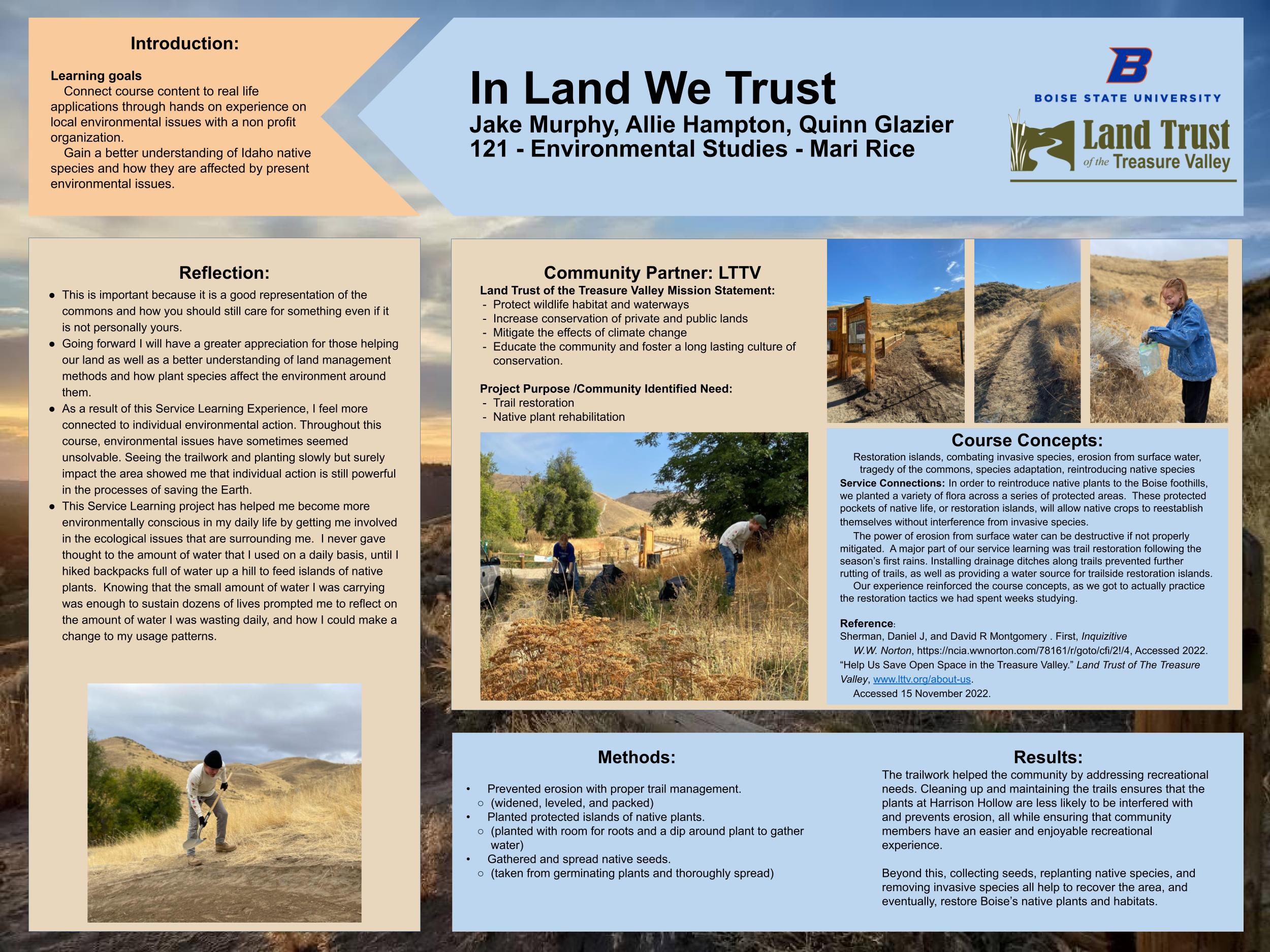Jake Murphy, Allie Hampton, Quinn Glazier
Dr. Mari Rice (Ed. D) – ENVSTD 121
Land Trust of the Treasure Valley

Introduction
Learning Goals
- Connect course content to real life applications through hands on experience on local environmental issues with a non profit organization.
- Gain a better understanding of Idaho native species and how they are affected by present environmental issues.
Community Partner: Land Trust of the Treasure Valley
Land Trust of the Treasure Valley Mission Statement:
- Protect wildlife habitat and waterways
- Increase conservation of private and public lands
- Mitigate the effects of climate change
- Educate the community and foster a long lasting culture of conservation.
Project Purpose /Community Identified Need:
- Trail restoration
- Native plant rehabilitation
- Course Concepts
Course Concepts
Restoration islands, combating invasive species, erosion from surface water, tragedy of the commons, species adaptation, reintroducing native species.
Service Connections
In order to reintroduce native plants to the Boise foothills, we planted a variety of flora across a series of protected areas. These protected pockets of native life, or restoration islands, will allow native crops to reestablish themselves without interference from invasive species.
The power of erosion from surface water can be destructive if not properly mitigated. A major part of our service learning was trail restoration following the season’s first rains. Installing drainage ditches along trails prevented further rutting of trails, as well as providing a water source for trailside restoration islands.
Our experience reinforced the course concepts, as we got to actually practice the restoration tactics we had spent weeks studying.
Reflection
This is important because it is a good representation of the commons and how you should still care for something even if it is not personally yours. Going forward I will have a greater appreciation for those helping our land as well as a better understanding of land management methods and how plant species affect the environment around them.
As a result of this Service Learning Experience, I feel more connected to individual environmental action. Throughout this course, environmental issues have sometimes seemed unsolvable. Seeing the trailwork and planting slowly but surely impact the area showed me that individual action is still powerful in the processes of saving the Earth.
This Service Learning project has helped me become more environmentally conscious in my daily life by getting me involved in the ecological issues that are surrounding me. I never gave thought to the amount of water that I used on a daily basis, until I hiked backpacks full of water up a hill to feed islands of native plants. Knowing that the small amount of water I was carrying was enough to sustain dozens of lives prompted me to reflect on the amount of water I was wasting daily, and how I could make a change to my usage patterns.
Methods

- Prevented erosion with proper trail management (widened, leveled, and packed)
- Planted protected islands of native plants (planted with room for roots and a dip around plant to gather water)
- Gathered and spread native seeds (taken from germinating plants and thoroughly spread)
Results
The trailwork helped the community by addressing recreational needs. Cleaning up and maintaining the trails ensures that the plants at Harrison Hollow are less likely to be interfered with and prevents erosion, all while ensuring that community members have an easier and enjoyable recreational experience.
Beyond this, collecting seeds, replanting native species, and removing invasive species all help to recover the area, and eventually, restore Boise’s native plants and habitats.